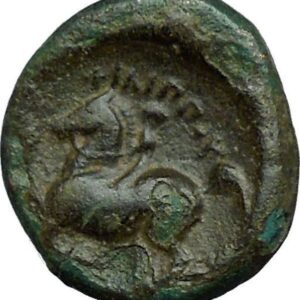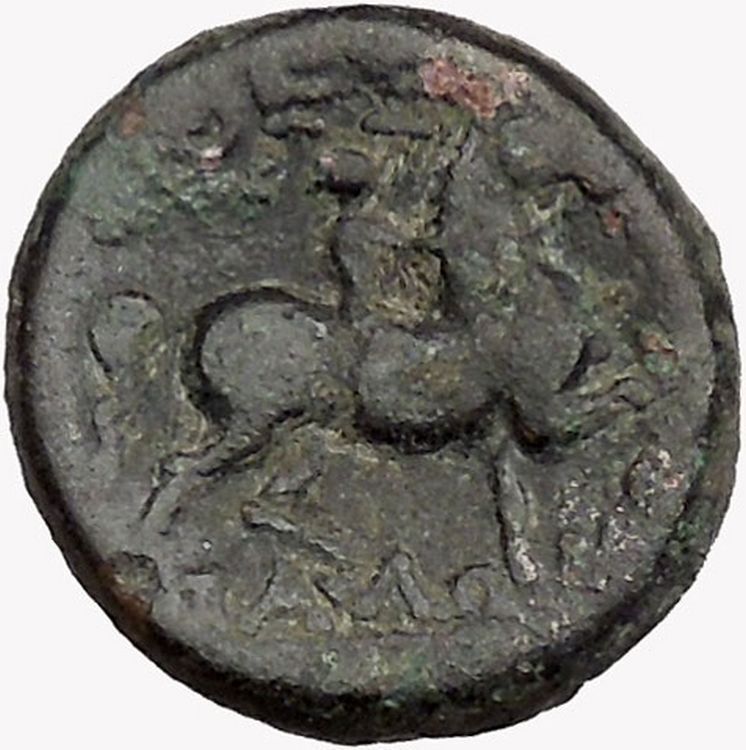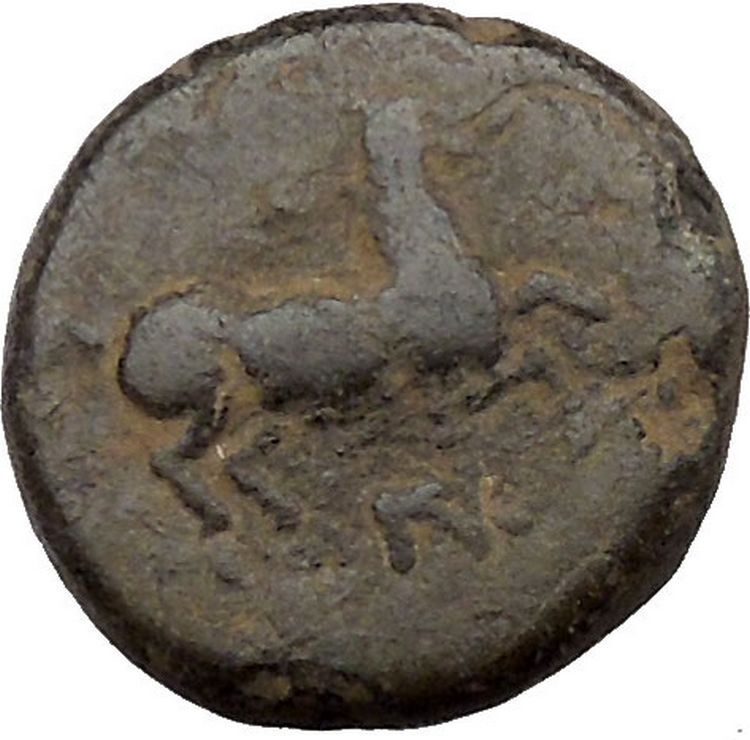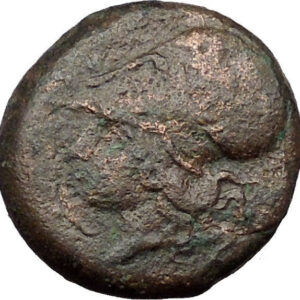|
Greek city of Philadelphia in Lydia
Bronze 14mm (5.39 grams) Struck 2nd-1st Century B.C.
Reference: Sear 4723; B.M.C.22.187,1; SNG Copenhagen 345 var. (monogram).
Circular Macedonian shield with star on boss.
ΦΙΛΑΔΕΛ / ΦEΩΝ above and beneath thunderbolt, monogram in upper field; all within olive-wreath.
Founded by Attalos II Philadelphos, King of Pergamon 159-138 B.C., Philadelphia was situated south-east of Sardes and commanded the important valley of Kogamis.
You are bidding on the exact item pictured, provided with a Certificate of Authenticity and Lifetime Guarantee of Authenticity.
Alaşehir (Greek: Philadélphia (Φιλαδέλφεια)) is a town and district of Manisa Province in the Aegean region of Turkey. It is situated in the valley of the Kuzuçay (Cogamus in antiquity), at the foot of the Bozdağ (Mount Tmolus in antiquity). The city is connected to İzmir by a 105 km (65 mi) railway.
It stands on elevated ground commanding the extensive and fertile plain of the Gediz River, (Hermus in antiquity) presents at a distance an imposing appearance. It has several mosques and Christian churches. There are small industries and a fair trade. From one of the mineral springs comes a heavily charged water popular around Turkey.
Within Turkey, the city’s name is synonymous with the dried Sultana raisins, although cultivation for the fresh fruit market, less labour-intensive than the dried fruit, gained prominence in the last decades. Named Philadelphia in antiquity, Alaşehir was a highly important center in the early-Christian and Byzantine periods, and remained a titular see of the Roman Catholic Church.
Ancient Philadelphia
Alaşehir began as perhaps one of the first ancient cities with the name Philadelphia. It was established in 189 BC by King Eumenes II of Pergamon (197-160 BC). Eumenes II named the city for the love of his brother, who would be his successor, Attalus II (159-138 BC), whose loyalty earned him the nickname, “Philadelphos”, literally meaning “one who loves his brother”. The city is perhaps best-known as the site of one of the seven churches of Asia in the Book of Revelation.
Lacking an heir, Attalus III Philometer, the last of the Attalid kings of Pergamum, bequeathed his kingdom, including Philadelphia, to his Roman allies when he died in 133 BC. Rome established the province of Asia in 129 BC by combining Ionia and the former Kingdom of Pergamum.
Roman Philadelphia
Philadelphia was in the administrative district of Sardis (Pliny NH 5.111). In AD 17, the city suffered badly in an earthquake, and the emperor Tiberius relieved it of having to pay taxes (Tacitus Annales 2.47, cf. Strabo 12.8.18, 13.4.10, John Lydus de mensibus 4.115). in response, the city granted honors to Tiberius. Evidence from coinage reveals that Caligula helped the city; under Vespasian, Philadelphia received his cognomen, Flavia. Under Caracalla, Philadelphia housed an imperial cult; its coins bore the word Neokoron (literally, “temple-sweeper”–caretaker of the temple). A small theater located at the northern edge of Toptepe Hill is all that remains of Roman Philadelphia.
Philadelphia in the Book of Revelation
Although several ancient cities bore the name of Philadelphia, this is definitely the one listed among the seven churches by John in the Book of Revelation. Philadelphia is the sixth church of the seven.(Revelation 1:11). A letter specifically addressed to the Philadelphian church is recorded in (Revelation 3:7-13). According to this letter, the Philadelphian Christians were suffering persecution at the hands of the local Jews, whom Revelation calls “the synagogue of Satan” (Revelation 3:9). The city’s history of earthquakes may lie behind the reference to making her church a temple pillar (Revelation 3:12). Permanency would have been important to the city’s residents.
Byzantine Philadelphia
Philadelphia was a prosperous Byzantine city, called the “little Athens” in the 6th c AD because of its festivals and temples. Presumably this indicates that the city wasn’t entirely converted to Christianity. Ammia, the Montanist prophetess, was from Philadelphia, however. In about the year 600 the domed Basilica of St. John was built, remains of which are the main archaeological attraction in the modern city. The Byzantine walls that once surrounded the city have all but crumbled away. A few remnants are still visible at the northeast edge of town, near the bus stand. The city was taken by the Seljuk Turks in 1074 and 1093-94. In 1098, during the First Crusade, it was recovered by Byzantine Emperor Alexios I. In the 11th to 15th centuries AD, it was the seat of the doux (governor) and stratopedarches (military commander) of the Thrakesion theme.
It was the center of several revolts against ruling Byzantine emperors- in 1182, led by John Komnenos Vatatzes, and 1188-1205 or 1206, led by Theodore Mangaphas, a local Philadelphian, against Isaac II Angelos. In the 14th century, Philadelphia was made the metropolis of Lydia by the Greek Orthodox patriarch of Constantinople, a status it still holds. It was granted this honor because the city did not capitulate to the Ottomans. The city was prosperous especially in the 13th and 14th centuries; there was a Genoese trading colony and the city was an important producer of leather goods and red-dyed silk (whence, perhaps, its Turkish name, which probably means “red city”). By the 14th century, the city was surrounded by Turkish emirates but maintained nominal allegiance to the Byzantine emperor. The town remained prosperous through trade and its strategic location.
Philadelphia was an independent, neutral city under the influence of the Latin Knights of Rhodes, when taken in 1390 by Sultan Bayezid I and an auxiliary Christian force under the Byzantine emperor Manuel II after a prolonged resistance, by which time all the other cities of Asia Minor had surrendered to the Ottomans. Manuel had been forced by Bayezid to participate in subjugating Philadelphia to Turkish rule, a bitter irony given its long resistance. Twelve years later it was captured by Timur, who built a wall with the corpses of his prisoners. A fragment of the ghastly structure is in the library of Lincoln Cathedral.
Philadelphia was the last Byzantine stronghold in inner Asia Minor. Its Greek inhabitants fled the town during World War I and created Nea Filadelfeia in Greece.
Turkish history
Greek occupation in Alaşehir (1920-1922)
The English traveler r Richard Chandler, visiting in the late 18th century, mentions that the town is of considerable size, with a Greek Orthodox population of about 300 families, none of whom apparently spoke Greek. He says further that the city is on an important road to Smyrna and was frequented by merchants, especially Armenians.
|










